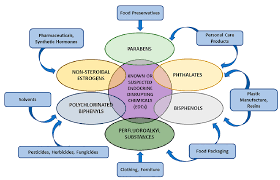
You start noticing changes that don’t match your child’s growth
Your child grows, but something feels off. They sleep longer, but wake up tired. Their appetite shifts. Mood swings come and go. There’s weight gain without reason. Or weight loss without illness. These aren’t always phases. Sometimes, they’re signals.
It’s not always about behavior—it might be hormonal
You hear “kids change.” You hear “it’s just puberty.” But your instinct says otherwise. Skin changes. Fatigue deepens. Focus fades. You begin to wonder if something internal is pushing these shifts. Not emotional. Not developmental. Hormonal.
Small exposures can lead to big internal shifts
Plastic bottles. Scented lotions. Pesticide-covered fruit. These seem harmless. But inside, they send messages. Signals that mimic hormones. Or block them. These aren’t toxins in the dramatic sense. They’re tiny disruptors with quiet consequences.
Your child’s body listens to signals that shouldn’t be there
An artificial chemical fits into a receptor. The body believes it’s estrogen. Or thyroid hormone. The system gets confused. The rhythm shifts. Growth accelerates. Or delays. Moods spike. Or flatten. And nothing looks “medical” at first glance.
The changes don’t follow a clear pattern
One day, they’re full of energy. The next, they crash after breakfast. They grow hair earlier than peers. Or much later. Their voice deepens too soon. Or not at all. It’s not linear. And that’s what makes it harder to notice.
Endocrine disruptors don’t show up on routine tests
You run labs. Everything looks “normal.” But the symptoms continue. Because standard tests don’t catch disruption. They look for damage. Not interference. These chemicals don’t destroy—they imitate. And that imitation confuses the entire system.
Not all kids are equally sensitive
One child drinks from plastic and thrives. Another reacts after one exposure. Genetics matter. So does timing. Exposure in early childhood may cause long-term shifts. The same exposure at age twelve might pass unnoticed. There’s no single rule.
Some effects show up years later
Breast development at eight. Menstrual changes at ten. Fertility issues in adulthood. These aren’t sudden. They’re layered. What begins quietly in toddlerhood may shape their future health. And once the pattern starts, it’s hard to trace backwards.
You don’t need to panic—but you need to pay attention
It’s not about fear. It’s about awareness. Watch how your child reacts to foods. To soaps. To plastic. To changes in water. Look for patterns. Not just symptoms. Trust what doesn’t feel right—even when it sounds minor.
You won’t always find a single cause
There isn’t always one product to blame. It’s not just one bottle. One food. One shampoo. It’s exposure over time. It’s layers. And that’s why it builds quietly. Without diagnosis. Without clarity. Just a sense that something’s off.
Some changes are reversible—others aren’t
When caught early, some symptoms fade. Removing disruptors may help. But not always. Some hormonal shifts stay. They become part of how the body operates. That’s why timing matters. Delay means permanence. Attention means possibility.
You may need to adjust your own environment too
Your child touches what you bring home. They breathe your air. They eat what you cook. If you change your products, their exposure drops. It’s not about blame. It’s about shared space. Their system reflects yours more than you think.
You’ll need support that understands the nuance
Not every doctor connects symptoms to hormones. Some say “they’ll grow out of it.” Others dismiss the concern. You may need to seek specialists. Providers who ask deeper questions. Who look past lab results. Who listen to the everyday signs.
Change starts with small, consistent shifts
Swap plastic for glass. Read ingredient lists. Filter your water. Choose fragrance-free. None of these fix everything. But they reduce the burden. And that’s the point. Less exposure means less confusion inside your child’s body.
